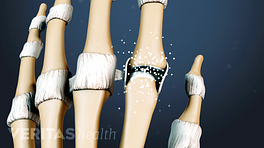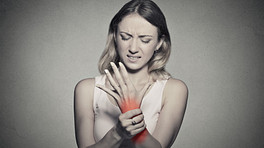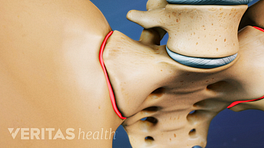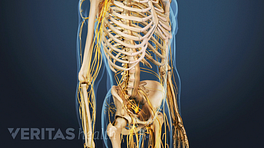Most people who have psoriatic arthritis experience both psoriasis and joint pain. Other symptoms are also common. Recognizing and reporting symptoms to a health care provider can help lead to a faster diagnosis, so treatment can begin.
In This Article:
- What Is Psoriatic Arthritis?
- Psoriatic Arthritis Symptoms
- Psoriatic Arthritis Causes
- Psoriatic Arthritis Diagnosis
- Psoriatic Arthritis Treatment
Psoriasis
Psoriasis can affect the skin anywhere, though it is most commonly seen in patches on the elbows, knees, and scalp. It typically appears as patches of raised red skin covered by white scales. It can also have a pimple-like or burned appearance. A psoriasis rash is often accompanied by severe itching and burning.
About 85% of people who develop psoriatic arthritis experience psoriasis first. 1 Ritchlin, CT, Colbert, RA, and Gladman, DD. "Psoriatic arthritis." New England Journal of Medicine. March 9, 2017. DOI: 10.1056/NEJMra1505557. People who have psoriasis are encouraged report aches, pains, and other symptoms to their primary health care providers or dermatologists.
Joint Pain
Experts estimate 96% of people who have psoriatic arthritis have joint pain in their fingers, toes, or joints in the limbs, such as the knees. 1 Ritchlin, CT, Colbert, RA, and Gladman, DD. "Psoriatic arthritis." New England Journal of Medicine. March 9, 2017. DOI: 10.1056/NEJMra1505557. When pain is in a toe or finger, the last knuckle tends to be affected. Pain is usually worse in the morning, lasting about an hour. The affected joints are inflamed and may be swollen and warm to the touch.
About 50% of people experience joint pain in their neck, back and/or hips. 1 Ritchlin, CT, Colbert, RA, and Gladman, DD. "Psoriatic arthritis." New England Journal of Medicine. March 9, 2017. DOI: 10.1056/NEJMra1505557. The most common area of the back to be affected is the sacroiliac (SI) joints of the lower back. When psoriatic arthritis causes back, neck, or hip pain it is called axial arthritis or spondyloarthritis.
For more in-depth information, see Sacroiliac Joint Dysfunction on Spine-health.com
Back and neck pain can help distinguish psoriatic arthritis from rheumatoid arthritis, which does not typically cause pain in the spine’s joints.
Other Symptoms of Psoriatic Arthritis
In addition to joint pain, a person with psoriatic arthritis may experience:
Dactylitis
About 40% to 50% of people how have psoriatic arthritis notice significant swelling in toes or fingers.
1
Ritchlin, CT, Colbert, RA, and Gladman, DD. "Psoriatic arthritis." New England Journal of Medicine. March 9, 2017. DOI: 10.1056/NEJMra1505557.
The skin over the joints may appear purple. This condition is called dactylitis, and may also be referred to as “sausage digits.” (Dactylitis can also be a sign of other conditions, such as certain infections and sickle cell disease.)
Joint stiffness
Inflammatory joint pain is often accompanied by stiffness. Like joint pain, joint stiffness is typically worse in the morning and improves during the day.
Enthesitis
Tendons connect muscles to bones, and ligaments attach bones to other bones. The point where a tendon or ligament attaches to a bone is called an enthesis. If an enthesis becomes inflamed, it is called enthesitis. About 30% to 50% of the people who have psoriatic arthritis also have enthesitis in one or more places.
2
Kehl AS, Corr M, Weisman MH. Review: enthesitis: new insights into pathogenesis, diagnostic modalities, and treatment. Arthritis Rheumatol 2016;68:312-22. As cited in Christopher T. Ritchlin, M.D., M.P.H., Robert A. Colbert, M.D., Ph.D., and Dafna D. Gladman, M.D. "Psoriatic arthritis." New England Journal of Medicine. March 9, 2017. DOI: 10.1056/NEJMra1505557.
The most common tissues affected by enthesitis are the Achilles tendon, located on the back of the leg near the ankle, and the plantar fascia, located on the sole of the foot.
See What Is Enthesopathy and Enthesitis?
Fingernail and toenail problems
Up to 87% of people experience changes in their fingernails and toenails.
1
Ritchlin, CT, Colbert, RA, and Gladman, DD. "Psoriatic arthritis." New England Journal of Medicine. March 9, 2017. DOI: 10.1056/NEJMra1505557.
They may notice small holes in their nail surfaces, called pitting. They may also notice ridges that travel horizontally across the nail, cracking, and/or discoloration. Sometimes nails may crack or separate from the nail bed.
Fatigue
A person with psoriatic arthritis may feel exhausted, even when he or she gets enough sleep. Fatigue may cause a person to feel overwhelmed and cut back on daily activities.
Diseases Associated with Psoriatic Arthritis
People who have psoriatic arthritis are more likely to get certain other medical conditions, which can produce their own set of symptoms. These conditions include:
- Inflammatory bowel disease, which causes gastrointestinal pain/diarrhea
- Chronic kidney disease, which may cause joint swelling in its later stages
- Diabetes, which can cause frequent urination, thirst, hunger, weight changes, and other symptoms
- Cardiovascular disease, which may result in high blood pressure, chest pain, heart fluttering, shortness of breath and other symptoms
- Inflammatory bowel disease, which can cause diarrhea, stomach pain and blood in the stool
- Conjunctivitis and uveitis, which are inflammatory eye conditions that can cause eye redness and pain and changes or loss of vision
About 8% of people with psoriatic arthritis have uveitis. 1 Ritchlin, CT, Colbert, RA, and Gladman, DD. "Psoriatic arthritis." New England Journal of Medicine. March 9, 2017. DOI: 10.1056/NEJMra1505557.
- 1 Ritchlin, CT, Colbert, RA, and Gladman, DD. "Psoriatic arthritis." New England Journal of Medicine. March 9, 2017. DOI: 10.1056/NEJMra1505557.
- 2 Kehl AS, Corr M, Weisman MH. Review: enthesitis: new insights into pathogenesis, diagnostic modalities, and treatment. Arthritis Rheumatol 2016;68:312-22. As cited in Christopher T. Ritchlin, M.D., M.P.H., Robert A. Colbert, M.D., Ph.D., and Dafna D. Gladman, M.D. "Psoriatic arthritis." New England Journal of Medicine. March 9, 2017. DOI: 10.1056/NEJMra1505557.










